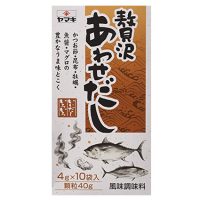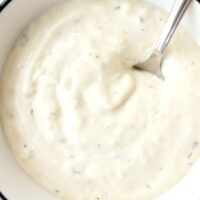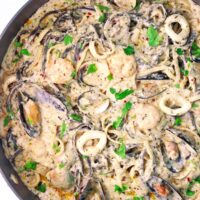Japanese Curry Udon with Pork Belly
This post contains affiliate links.
Tender thin sliced pork belly, onion, carrots, and fragrant aromatics get simmered in a rich and savory curry broth and served with slippery and chewy udon noodles. This Japanese Curry Udon is quick and easy to make in 30 minutes with store-bought Japanese curry roux cubes, robustly flavorful, and a comforting and satisfying meal!
Japanese Curry Udon is one of my all-time favorite easy weeknight meals. It’s super simple to throw together on any given weeknight, jam-packed with flavor, and super warming and comforting! 💛
We have here:
- A savory, rich, and a spicy Japanese curry broth.
- Tender melt-in-your-mouth thin slices of pork belly. (Other protein options can be used if pork is not your thing.)
- A few everyday veggies and aromatics. (Onion, carrots, garlic, ginger, chilies, and spring onion for garnish).
- All served with slippery and chewy udon noodles!
While similar to my Japanese Pork Belly Curry in many ways, the curry is slightly soupier here and more of a broth. The consistency is not too thick or watery, and this makes it perfect for slurping with the silky udon noodles.
Bonus? It’s an easier, less messy, and healthier alternative to another popular dish in Japan – tonkatsu or katsu curry udon. They involve frying Panko breadcrumbs coated pork or chicken cutlets and are served over curry udon.
Trust me though when I say this curry udon sacrifices nothing on flavor! Try this recipe once and I think you’ll love it and be making it over and over again!
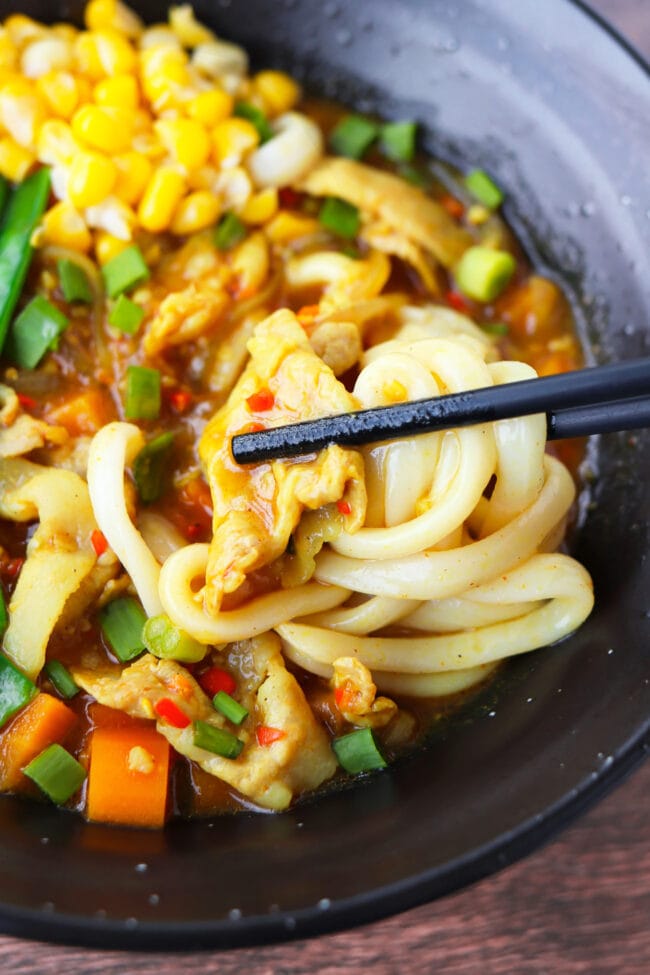
Why This Recipe Works
- Quick and easy. It’s ready to go in 30 minutes, which makes it perfect for busy weeknights!
- Explosion of RICH and BOLD savory flavors. The curry broth is full of rich and savory umami notes and robustly flavorful thanks to store-bought Japanese curry roux cubes and a few additional seasonings.
- Udon noodles are slurp-i-licious! Chewy udon noodles are wonderful to slurp and chew on, and taste incredible in the curry broth! They’re also nice and filling, which makes this curry udon with pork a satisfying and warming meal.
- Melt-in-your-mouth pork belly. Thin slices of hotpot/shabu shabu style pork belly meat are incredibly tender and super tasty in this curry udon!
- Customizable. You can swap for your favorite protein, adjust the curry broth consistency, and adjust the spice level to suit your preference!
Ingredients
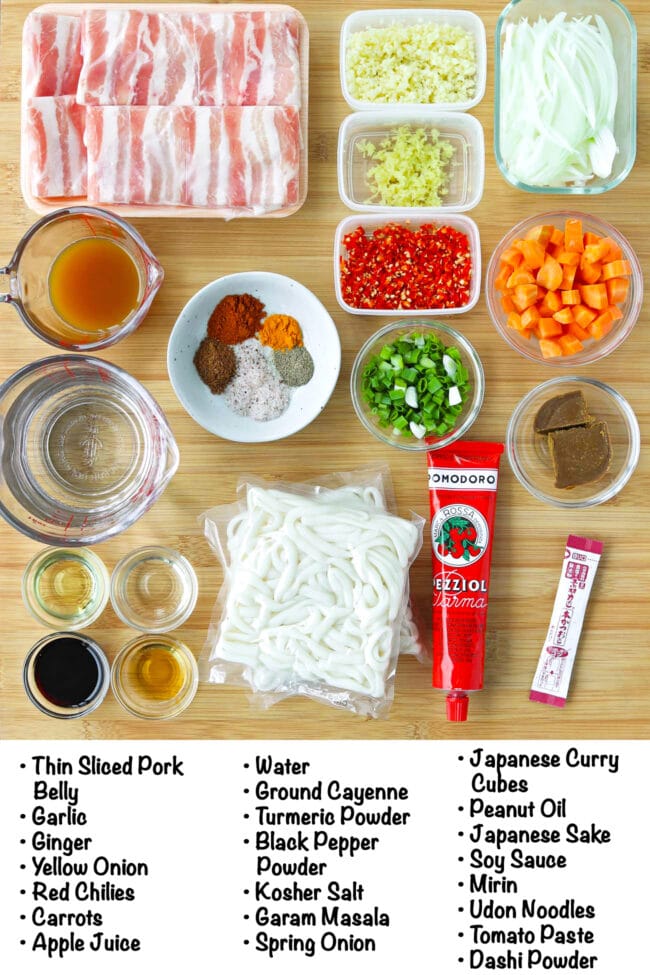
- Pork: I’ve used thin sliced pork belly (hotpot/shabu shabu style meat) and cut the strips into smaller bite-sized pieces. Pork loin slices can also be used for a leaner option. Look for this type of pork in packages in an Asian supermarket or Japanese groceries store.
- Aromatics: Some garlic, ginger, and fresh Bird’s Eye red chilies for extra heat. Feel free to use any other hot red chilies that are easily available to you. Omit or use less for a milder curry broth.
- Veggies: I kept it simple and only used yellow onion and carrots. However, you can add peeled and diced potatoes too if you like.
- Dashi Powder Sachet (Japanese fish stock powder): Although homemade dashi soup stock is fairly quick and easy to make, it requires some difficult to find ingredients like kombu (dried kelp), katsuobushi (dried bonito flakes), iriko or niboshi (dried anchovies or sardines respectively), and/or dried shitake mushrooms. Using “instant” dashi powder is the quickest and easiest way to make dashi soup stock, which is commonly used in several dishes in Japanese cuisine. All you have to do is simmer the dashi powder briefly with water! You can even add it directly to wok with the other ingredients along with water, but I prefer to make the dashi soup stock separately first. Dashi powder comes in individual portioned sachets and can be found in Asian supermarkets, Japanese groceries stores, and online.
- Japanese Curry Cubes: I use the large S&B Golden Curry Roux cubes and highly recommend this brand! These curry cubes come in varying spice levels – mild, medium, hot, and extra hot. Use the mild or medium curry cubes if you’re not big on heat. If you love your spicy food, go for the hot or extra hot curry cubes! We use the extra hot curry cubes in my home for dishes like my Japanese pork belly curry, Indian onion chicken curry, and this Japanese Curry Udon. I should mention that I’ve used less curry cubes than called for on the package because I prefer to add other seasonings to add more robust flavors.
- Udon Noodles: There are many options when it comes to these chewy thick Japanese wheat noodles. However, try to get your hands on sanuki udon. I used vacuum sealed packs of fresh sanuki udon noodles, but the frozen or dried variety can be used instead too. They’re readily available in Asian supermarkets and can also be found in some mainstream grocery stores.
- Apple Juice (no sugar added): Japanese curry cubes often have grated apple incorporated in them to sweeten the curries. Since the S&B curry cubes don’t, I add apple juice to the broth to add sweetness.
- Japanese Sake: This is a Japanese cooking wine that adds depth of flavor. It’s great for flavoring meats, curries, and stews. Feel free to omit it if you prefer to not cook with alcohol.
- Spices & Seasonings: Kosher salt, black pepper powder, turmeric powder (optional – to enhance the color), garam masala, and ground cayenne. If using a different brand of Japanese curry cubes, you may need less or more salt than what I’ve indicated. Adjust the kosher salt to taste and use half the amount if using iodized table salt. Although you can use store-bought garam masala, a homemade version of this Indian spice blend is preferred as it makes the curry broth SO much more flavorful! Check out my quick & easy recipe for homemade garam masala. It’ll keep for months in your pantry and you can use it in this Japanese curry udon and also in other Indian dishes. Use less ground cayenne based on your heat level preference (or omit completely for a milder curry broth).
- Double Concentrated Tomato Paste: To add rich tangy flavors.
- Mirin: This is a Japanese sweet rice wine and available in Asian grocery stores. It’s often used as a sweetener in Japanese cuisine. If you prefer not to cook with alcohol, substitute with honey instead.
- Low Sodium Light Soy Sauce: Just a splash to add savory umami notes to the broth.
- Peanut Oil: Or use any other neutral flavored cooking oil such as vegetable, canola, rice bran, etc.
- Spring Onion (Scallion/Green Onion): For garnish.
- Optional toppings: Blanched sweet corn kernels and snow peas, or any other blanched veggie toppings you like! You can also top each bowl with half of a soft boiled egg and crispy fried shallots for extra crunch.
Full ingredient list and amounts are in the recipe card below.
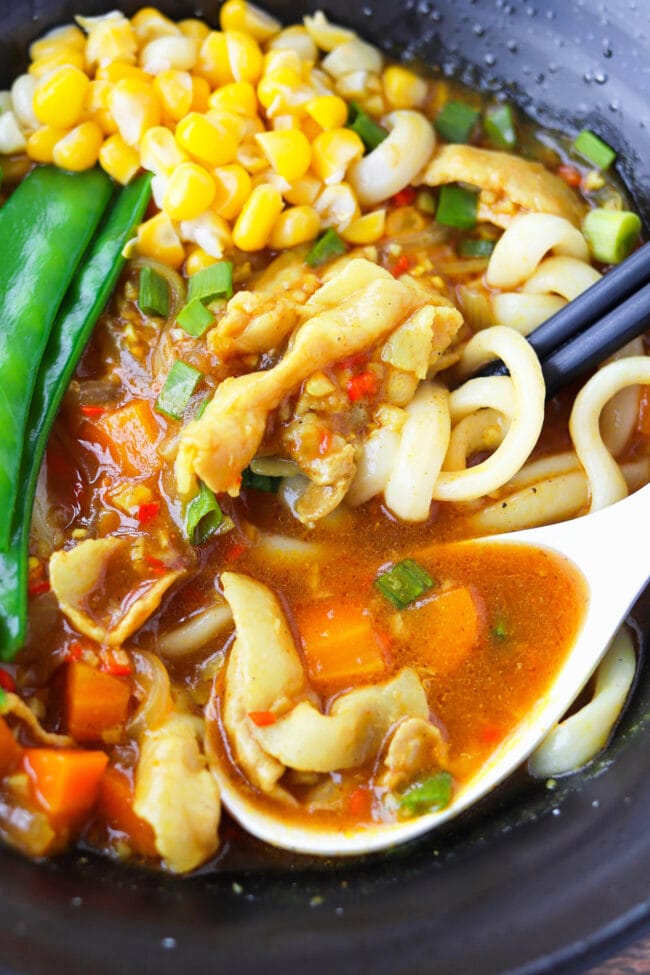
How to Make Japanese Curry Udon with Pork Belly
1. Make the dashi stock. Heat water in a small saucepot on the stovetop. Once the water starts to simmer, stir in the dashi powder. Allow to simmer briefly, then transfer the dashi stock to a heatproof measuring cup.
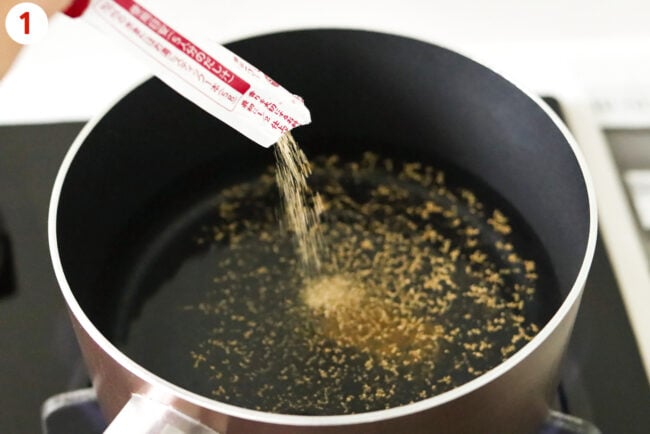
2. Sauté the onion and aromatics. In a little oil in a wok or stockpot until the onion has softened and the ginger, garlic, and chilies are fragrant.
3. Cook the pork. Push everything to the side of the wok and the pork belly strips. Pour the sake on top of the pork and sauté until almost no longer pink. Then stir-fry to combine with everything else.
4. Add carrots and dashi stock. Toss the carrots until slightly softened, then pour in the dashi stock. Stir to combine. Cover and simmer for a few minutes or until the carrots are tender.
5. Stir in the curry cubes. Do this over low heat. Stir continuously until they’ve fully dissolved.
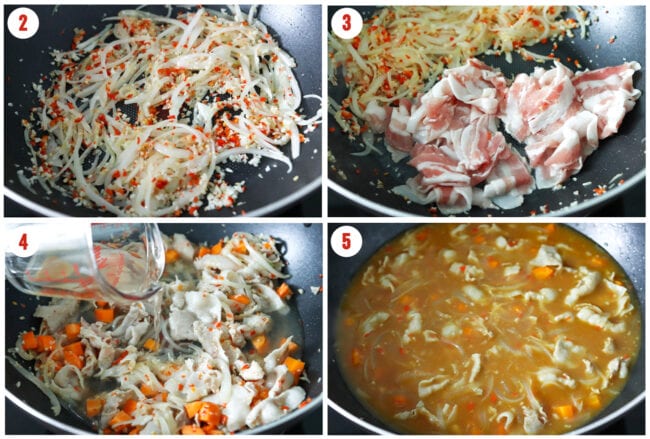
6. Season. Turn the heat back up to medium-low and stir in the apple juice, all of the spices & seasonings, tomato paste, mirin, and soy sauce. Simmer for a few minutes, stirring occasionally to prevent anything from sticking to the bottom of the wok. Switch off the heat and cover to keep warm.
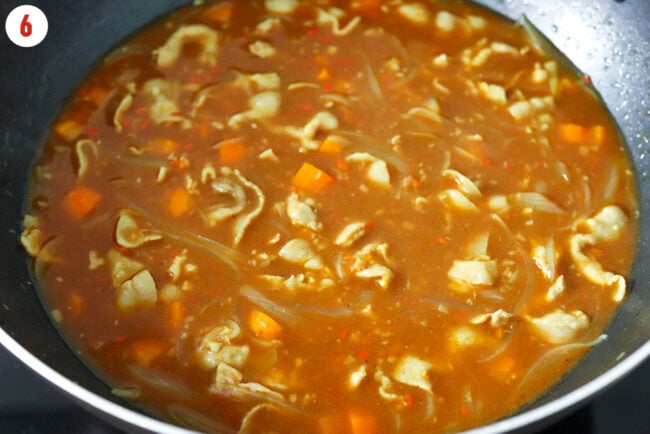
7. Assemble noodle bowls: Cook the udon noodles in a separate pot of boiling water as per package instructions. Drain and divide evenly into bowls. Ladle the Japanese pork curry broth evenly over the noodles. Top with any blanched veggies of your choice (I used blanched sweet corn kernels and snow peas).
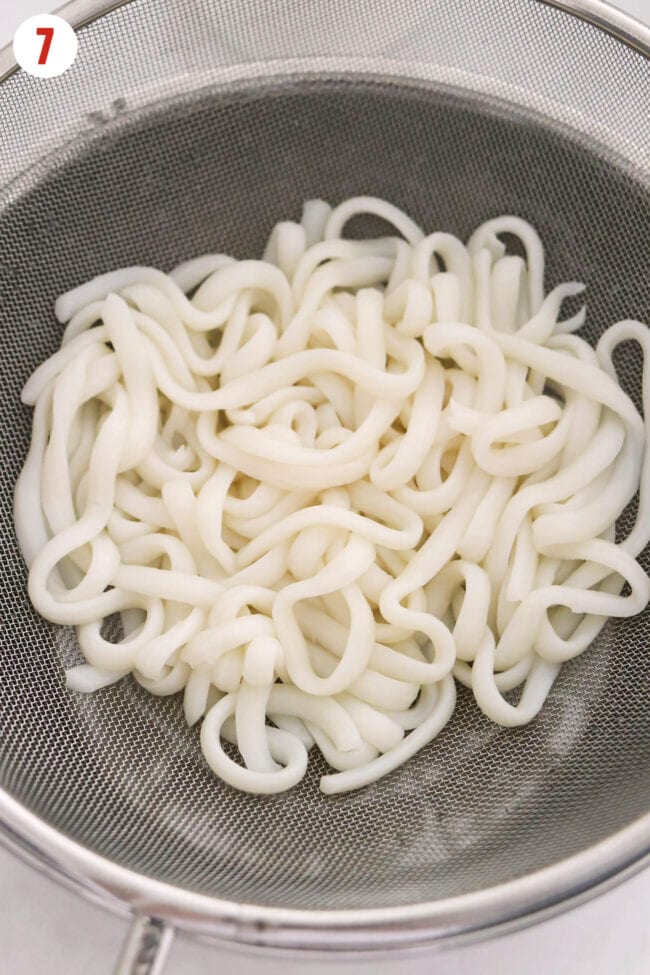
Garnish with chopped spring onion. Then serve and enjoy!

Full detailed instructions are in the recipe card below.
Cook’s Tips
- Make it soupier. Add more dashi stock to make the curry broth soupier.
- Make the curry broth thicker. Add corn starch slurry (2 teaspoons corn starch mixed with 2 tablespoons of water) and simmer for a minute until thickened to your desired consistency. Alternatively, simmer the broth longer over low heat after adding the curry roux cubes. Since they have wheat incorporated in them, simmering longer will cause the broth to thicken further.
- Adjust spice level to taste. For a milder curry udon broth, use mild Japanese curry roux cubes and omit the fresh red chilies and ground cayenne. For more spicy flavors, use the hot or extra hot curry roux cubes and add more fresh red chilies and ground cayenne. You can even drizzle with pure chili oil (without seeds/flakes) on top.
- Make ahead tips. Make the curry broth up to 3 days in advance and store in an airtight sealed container in the fridge. The flavors tend to intensify over time and will be more delicious the next day. However, cook the udon and assemble noodle bowls only when ready to serve. Combining the noodles with the curry broth will cause them to absorb the broth over time and bloat.
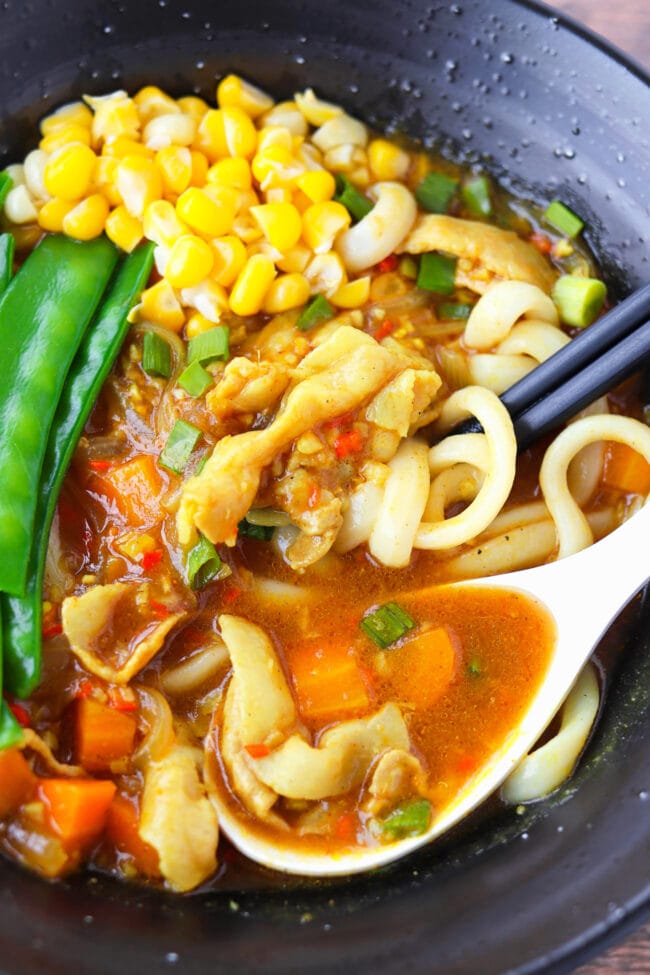
FAQs
You can substitute with chicken, beef, or vegetable stock instead.
I recommend buying sanuki udon noodles for curry udon. While firm, the texture is smoother and more tender than other varieties. They are also more slippery, which makes them easier to slurp up. Fresh, vacuum sealed packs of fresh udon, and frozen udon noodles are preferred over the dried variety because of textural differences. Dried udon noodles tend to be thinner and not as chewy. Frozen udon has a lovely bouncy texture. It can be found in the frozen section of Asian supermarkets and some mainstream supermarkets.
No. Udon noodles are made from wheat flour as the main ingredient, as well as salt and water. Rice noodles are made from rice flour as the main ingredient. However, these days you can purchase dried brown rice udon noodles which are usually gluten-free.
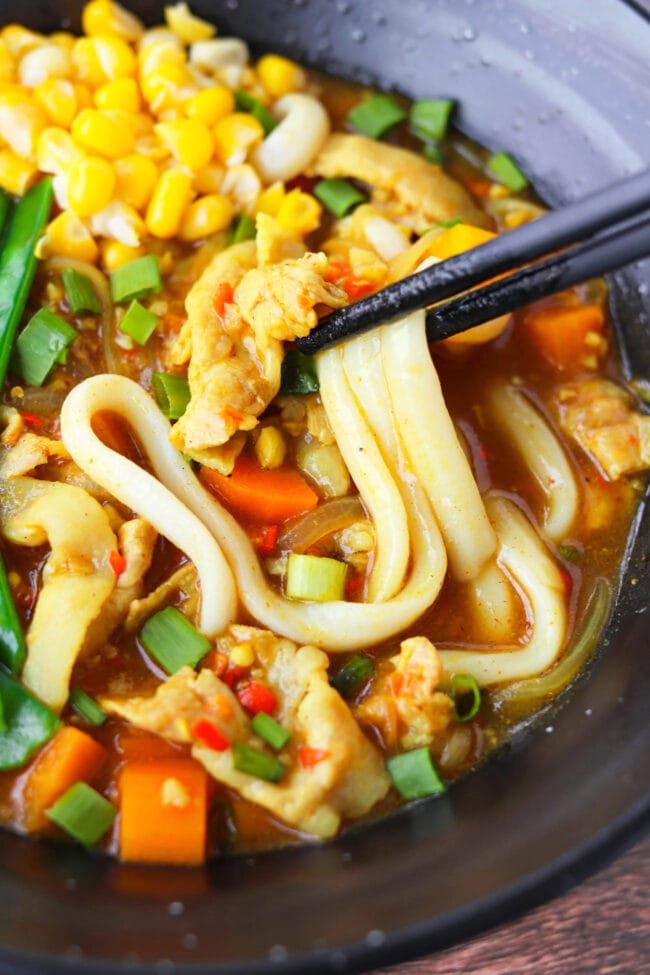
Variations
- Switch up the protein. Feel free to swap the thin sliced pork for thin sliced lamb or beef. Alternatively, use diced boneless and skinless chicken thighs or shrimp/prawns. If using shrimp/prawns, add them during the last 3-4 minutes of simmering the curry broth (after adding the curry cubes and spices & seasonings) so that they don’t overcook.
- Make it vegetarian/vegan. Omit the meat and add either crispy pan-fried tofu cubes or fried tofu puffs (‘tau pok’ – available in packages in the fridge section of Asian supermarkets). Use konbu (kelp) dashi or shiitake (mushroom) dashi, or simply use veggie stock instead. Feel free to add more veggies to the broth such as snap peas, potatoes, mushrooms (sliced shitake or other Asian mushrooms), green peas, broccoli, etc. Finally, make sure that the Japanese curry roux cubes you are using are vegetarian/vegan. (S&B Golden Curry brand curry roux cubes are vegetarian/vegan certified.)

More Easy Japanese Recipes
More Spicy Noodle Soups
- Udon Noodle Soup with Chicken & Mushrooms
- Dan Dan Noodles
- Korean Seafood Soup Noodles (Jjamppong)
- Curry Laksa
- Or browse the entire Noodles and Noodle Soups recipe collections.
MADE THIS RECIPE? If you make this recipe, leave a comment below and let me know how you liked it! Take a photo and tag it with @thatspicychick on Instagram and hashtag it #thatspicychick and I’ll be sure to share your masterpiece!
STAY CONNECTED! You can also follow me on Pinterest, Facebook or Instagram. Sign up for my email list to get my latest recipe in your inbox weekly!
PrintJapanese Curry Udon with Pork
Tender thin sliced pork belly, onion, carrots, and fragrant aromatics get simmered in a rich and savory curry broth and served with slippery and chewy udon noodles. This Japanese Curry Udon is easy to make in 30 minutes and a weeknight winner meal!
- Prep Time: 10
- Cook Time: 20
- Total Time: 30 minutes
- Yield: 2 1x
- Category: Dinner
- Method: Simmer
- Cuisine: Japanese
Ingredients
For the Japanese Curry Broth with Pork:
- 200 grams / 7 ounces thin sliced Pork Belly (hotpot/shabu shabu style meat) – cut into 2-inch wide strips
- ½ small Yellow Onion – thinly sliced
- 1 TBLS grated Ginger
- 5 Garlic cloves – minced
- 2–8 fresh Red Chilies (I used Bird’s Eye, but any small hot red chilies will work), to taste – chopped
- 1 small (about 100 grams / 3.5 ounces) Carrot – peeled, small diced
- 750ml / 3 cups Water
- 1 x 5-gram sachet Dashi Powder (Japanese fish stock powder – see notes*)
- 1 TBLS Peanut Oil (or other neutral flavored cooking oil)
- 1.5 large Japanese Curry Cubes (about 41.25 grams / 1.45 ounces – see notes*) – cut into quarters
- 60ml / ¼ cup Apple Juice (no sugar added)
- 1 TBLS Japanese Sake (optional)
- 1.25 TSP Kosher Salt, to taste (use a little less than ¾ TSP if using iodized table salt)
- ¼ TSP Black Pepper Powder, to taste
- ¼ TSP Turmeric Powder (optional)
- ¾ TSP Garam Masala (homemade garam masala preferred)
- ¼ – ¾ TSP ground Cayenne, to taste
- 1 TBLS Double Concentrated Tomato Paste
- ¾ TBLS Mirin (or 2 TSP honey), to taste
- 1 TBLS Low Sodium Light Soy Sauce
To Serve:
- 400 grams / 14 ounces / 2 servings Udon Noodles (I used vacuum sealed packs – see notes*)
- 1 Spring Onion (Scallion/Green Onion) – chopped
- Optional toppings: Blanched sweet corn kernels (1/2 cup) and snow peas (50 grams / 1.76 ounces), half of a soft-boiled egg for each serving, crispy fried shallots
Instructions
Prep:
- Prepare the fresh ingredients: Cut the pork belly into 2-inch wide strips. Prepare the yellow onion, ginger, garlic, red chilies, and carrot as indicated in the ‘Ingredients’ section.
- Make the dashi stock: Heat 750ml/3 cups water in a small saucepot over medium-high heat. Once the water starts to simmer, add the dashi powder and stir to combine. Turn the heat down to medium-low and simmer for a minute. Switch off the heat and transfer to a heatproof measuring glass and set aside. Rinse out the saucepot to cook the udon noodles in later.
For the Japanese Pork Belly Curry Broth:
- Sauté the onion and aromatics: Heat 1 tablespoon peanut oil in a large nonstick wok or stockpot over medium-high heat. Once hot, add the yellow onion and sauté for 2-3 minutes until softened. Add the ginger, garlic, and red chilies and sauté for another minute until fragrant.
- Cook the pork: Push everything to the side of the wok and add the pork. Pour the Japanese sake on top of the pork and sauté for 1-2 minutes until almost no longer pink. Then stir-fry to combine with everything else in the wok.
- Add carrots and dashi stock: Add the carrots and toss to combine for a minute until slightly softened. Pour in the dashi stock and give everything a good stir. Cover and simmer for 8-12 minutes, or until the carrots are tender.
- Stir in the curry cubes: Uncover and turn the heat down to low. Add the quartered Japanese curry cubes and stir continuously for 3-5 minutes until fully dissolved and integrated.
- Season: Turn the heat back up to medium-low and stir in the apple juice, kosher salt, black pepper powder, turmeric powder, ground cayenne, double concentrated tomato paste, mirin, and low sodium light soy sauce. Simmer for 3 minutes, stirring occasionally to prevent anything from sticking to the bottom. Switch off the heat and cover to keep warm.
To Assemble Noodle Bowls:
- Cook the noodles: Bring water to a boil in the pot you used to make the dashi stock. Add the udon noodles and boil according to package instructions. Drain and divide the noodles evenly into two bowls.
- Blanch the veggies toppings (optional): Add water to the pot and bring to a boil again. Add the snow peas and sweet corn kernels and blanch for 1.5-2 minutes. Drain into a fine mesh strainer and transfer to an ice water bath. Then drain immediately again. Pick the snow peas out of the strainer and pat dry with a paper towel.
- To Serve: Ladle the Japanese pork curry broth evenly over the noodle bowls and garnish with chopped spring onion. Top with the snow peas and spoon the sweet corn kernels on top. Serve immediately.
Notes
- Pork. Hotpot/shabu shabu style thin sliced pork belly meat is available in packages at Asian supermarkets. You can use hotpot style sliced pork loin for a leaner option instead or beef or lamb if you prefer.
- Japanese Curry Cubes. I used S&B Extra Hot Curry Roux Cubes, but you can use mild, medium, or hot curry cubes based on your heat level preference. Look for Japanese curry cubes in Asian supermarkets or a specialty Japanese ingredients store.
- Dashi Powder Sachet (Japanese fish stock powder). Using “instant” dashi powder is the quickest and easiest way to make dashi soup stock. Dashi powder comes in individual portioned sachets and can be found in Asian supermarkets, Japanese groceries stores, and online. If you can’t find it, substitute with chicken, beef, or vegetable stock.
- Adjust spice level to taste. For a milder curry udon broth, use mild Japanese curry roux cubes and omit the fresh red chilies and ground cayenne. For more spicy flavors, use the hot or extra hot curry roux cubes and add more fresh red chilies and ground cayenne. You can even drizzle pure chili oil (without seeds/flakes) on top of your bowl.
- Which udon noodles to buy? I recommend buying sanuki udon noodles for curry udon. While firm, the texture is smoother and more tender than other varieties. They are also more slippery, which makes them easier to slurp up. Fresh, vacuum sealed packs of fresh udon, and frozen udon noodles are preferred over the dried variety because of textural differences. Dried udon noodles tend to be thinner and not as chewy. Frozen udon has a lovely bouncy texture. You can find it in the frozen section of Asian supermarkets and some mainstream supermarkets.
- How much udon noodles do I need? This recipe makes enough curry broth for 2 servings of udon noodles. Below are amounts you’ll need depending on the type of udon noodles you’re using.
- Fresh udon in vacuum sealed packs: 400 grams / 14 ounces.
- Frozen udon: 500 grams / 1.1 pounds.
- Dried udon: 200 grams / 7 ounces.
- Make ahead tips. Make the broth up to 3 days in advance and store in an airtight sealed container in the fridge. The flavors tend to intensify over time and will be more delicious the next day. However, cook the udon and assemble noodle bowls only when ready to serve. Combining the noodles with the curry broth will cause them to absorb the broth over time and bloat.
- See ‘Variations’ section in post above for other protein options and how to make vegetarian/vegan curry udon.
Nutrition
- Serving Size: 1 serving
- Calories: 884
- Sugar: 15.2g
- Sodium: 2255.1mg
- Fat: 47.9g
- Saturated Fat: 5.1g
- Unsaturated Fat: 5.6g
- Trans Fat: 0g
- Carbohydrates: 87.2g
- Fiber: 4.6g
- Protein: 19.7g
- Cholesterol: 1.7mg
This post may contain affiliate links. We are a part of the Amazon Services LLC Associates Program, an affiliate advertising program designed to provide a means for us to earn a small commission (at no extra cost to you) by linking to Amazon.com and affiliated sites. The nutritional information provided is approximate and can vary based on several factors. It should only be used as a general guideline. For more information, please see our Disclosure.





